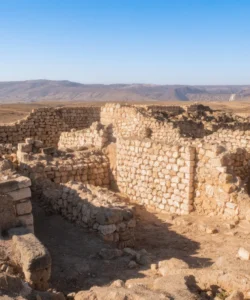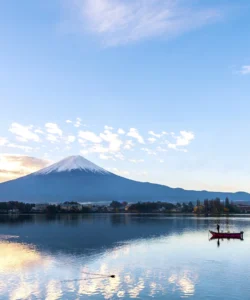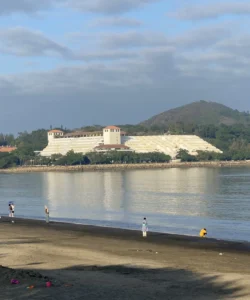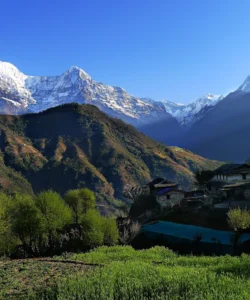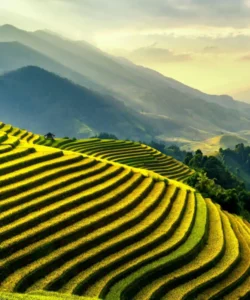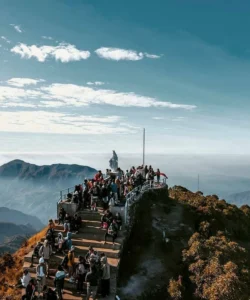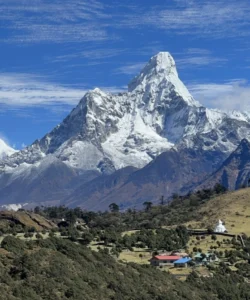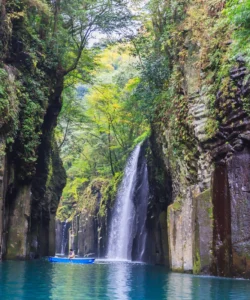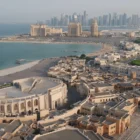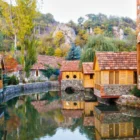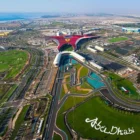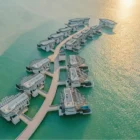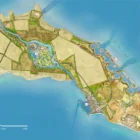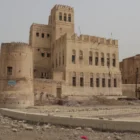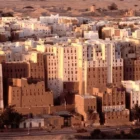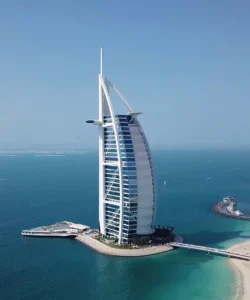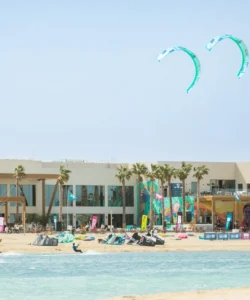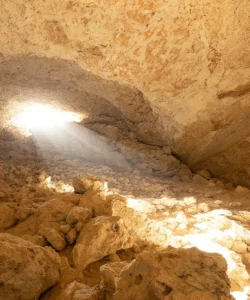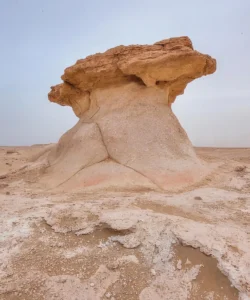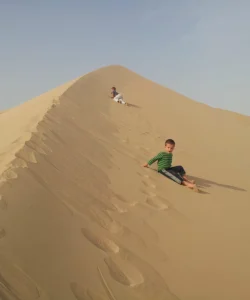In the stark, beautiful desert landscape of western Qatar lies the Ras Abrouq peninsula, an area famous for its otherworldly limestone rock formations. Among the most iconic of these are the Zekreet “mushroom rocks”—spectacular natural sculptures carved by centuries of wind and erosion. These formations, standing in a vast, arid expanse, create a surreal, almost lunar-like environment. They are a prime example of the country’s hidden natural beauty and offer a striking contrast to the modern metropolis of Doha.
Listen to an introduction about Zekreet Mushroom Rocks
Name and Address
- Name: Zekreet’s Mushroom Rocks (also known as Ras Abrouq or Bir Zekreet rock formations).
- Address: Located on the Ras Abrouq peninsula, near the village of Zekreet on the west coast of Qatar, approximately 80-90 kilometers west of Doha.
How to Get There
Visiting the mushroom rocks is an off-road adventure that requires proper transportation and planning.
- By Car: The journey from Doha takes approximately 1.5 hours. You will take the Dukhan Highway west from Doha and then turn north towards Zekreet. While some of the main roads are paved, the final stretch to the rock formations is on unpaved desert tracks.
- Vehicle Recommendation: A 4×4 vehicle is essential to navigate the rugged, uneven, and sometimes sandy terrain safely. It is not advisable to attempt the journey in a standard sedan.
- Guided Tours: This is the most popular and recommended way to visit. Numerous tour operators in Doha offer half-day or full-day trips to the Zekreet peninsula. These tours typically include a 4×4 vehicle with an experienced driver and often combine the visit with other nearby attractions like Richard Serra’s East-West / West-East sculpture and Zekreet Fort.
Landscape and Geological Phenomenon
The landscape of Zekreet is a unique desert environment, and the mushroom rocks are its geological centerpiece.
- Geological Formation: The mushroom rocks are a classic example of a landform called a “rock pedestal” or “hoodoo.” They are composed of soft sedimentary limestone. Over thousands of years, wind-driven sand has acted like sandpaper, eroding the base of the rock formations at a faster rate than the top. The lower part is worn away more quickly because the wind carries the highest concentration of abrasive sand particles closer to the ground.
- Surreal Landscape: The result is a stunning landscape dotted with large, mushroom-shaped pillars, each with a wide cap balancing on a much narrower stem. The chalky white and pale brown colors of the limestone, set against the desert floor and blue sky, create a dramatic and highly photogenic scene.
- Brouq Nature Reserve: The area is part of the Brouq Nature Reserve, a protected area where you might also spot native wildlife, including Arabian Oryx and gazelles, often seen roaming near the rock formations.
What Makes It Famous
Zekreet’s Mushroom Rocks are famous for their unique natural beauty and their location within a region rich with other attractions.
- Otherworldly Scenery: The primary draw is the striking, almost alien-like appearance of the landscape. It is one of the most photographed natural sites in Qatar.
- A Natural Sculpture Park: The wind-carved formations are seen as nature’s art, each rock a unique sculpture. The most famous is a single, perfectly balanced mushroom-shaped rock that has become an icon of the region.
- Proximity to Public Art: The rocks are located a short drive from Richard Serra’s monumental desert art installation, East-West / West-East. This has created a popular tourist trail that combines a visit to a world-class art piece with a tour of a stunning natural wonder.
- Desert Adventure: A trip to Zekreet is a quintessential Qatari desert experience, offering a sense of remoteness and adventure far from the city. It’s a popular spot for camping, stargazing, and exploring the rugged coastline of Zekreet Beach.
Differences from Other Sites
The Mushroom Rocks offer a very different experience compared to Qatar’s other natural and man-made wonders.
- Geological vs. Coastal/Acoustic Phenomenon: Unlike Khor Al Adaid, which is defined by the meeting of sea and dunes, or the Singing Sand Dunes, which are famous for their sound, the mushroom rocks are a purely geological and visual spectacle. The attraction is their unique shape and the stark beauty of the limestone desert.
- Focus on Stillness and Form: The experience at Zekreet is one of quiet contemplation of ancient, static forms. This contrasts with the dynamic energy of dune bashing at Khor Al Adaid or the interactive nature of making the Singing Sand Dunes perform.
- Combination with Man-Made Art: The synergy with the nearby Richard Serra sculpture is unique. Visitors can experience two vastly different types of monumental sculpture—one carved by nature over millennia, the other forged by a contemporary artist—in the same remote landscape.
- West Coast vs. East/South: The location on Qatar’s rugged west coast provides a different desert environment compared to the rolling golden sands found in the south towards the Inland Sea. The terrain is more rocky and barren, giving it a distinct character.
Zekreet Mushroom Rocks Photos:

































